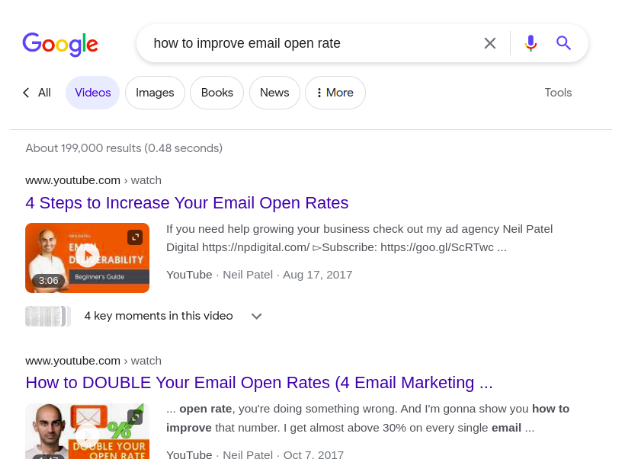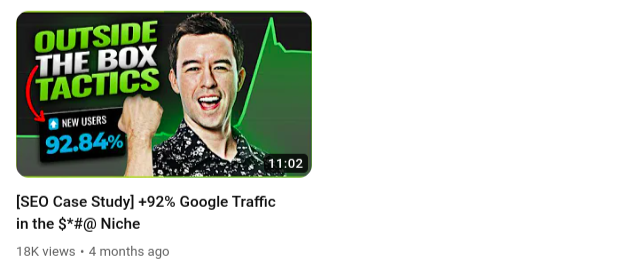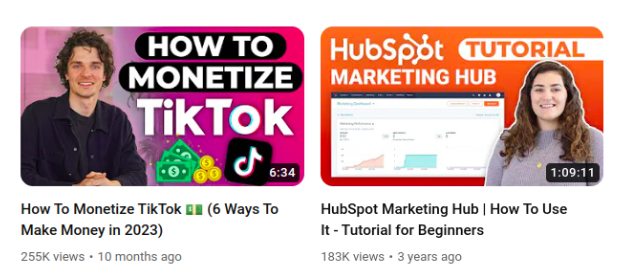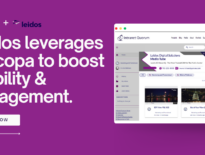Mastering YouTube Titles: The Key to Clicks and Conversions
YouTube is all about first impressions. If the first couple of seconds of a video doesn’t capture the viewer’s attention, they may not finish it. The thumbnail can dictate whether your video gets clicked on.
YouTube video titles have an influence on both CTR in YouTube search and recommendations as well as whether your video gets found in the first place. In fact, YouTube video titles are among the top three factors that affect video play rate.
This guide will walk you through how to master the art of creating YouTube video titles and showcase several video titles that you can take inspiration from.
What is a Good YouTube Title?
The first few seconds of your YouTube video determine whether the viewer watches it to the end and converts. The title determines whether your video gets found and clicked on. But how exactly does a great YouTube video title look?
Firstly, it contains the main keyword your video is targeting or a variation of it. It’s crucial to know what keywords people would use to find your video and to deliberately use them in the title. That way, you show both the user and the search engine what the video is about.
YouTube video titles should also match the topic of the video. They should not only describe the contents but also be styled appropriately. This also means the style and tone of the title should be appropriate for the topic. The same goes for matching your audience and your brand’s tone of voice.
Why Is the YouTube Video Title So Important?
Creating engaging YouTube video titles that match your goals is important for a number of reasons.
Just like with thumbnails, users use YouTube video titles to judge your video. They form the first impression, often in a matter of seconds. Thumbnails are important for catching attention in the first place, and arguably, they’re more important for entertaining videos.
If you’re making educational videos for your business, users will probably pay more attention to the title when deciding what video to watch.
A good title is also key to standing out among competing videos. If the title is both descriptive and peaks the interest of viewers, your video might have a better CTR than others, and eventually end up ranking higher in search.
SEO is another reason why optimizing YouTube video titles is a good idea. A combination of keyword optimization and CTR optimization means your video will be found by more people as it will rank higher on YouTube search and on Google.
Engaging YouTube Video Titles to Get Clicks and Conversions
The difficulty in crafting a good YouTube video title is that you have to fit so much meaning into a short phrase. And you have to make it fit your audience’s expectations and your brand voice.
It takes a bit of trial and error to come up with your own unique formula for YouTube video titles. To come up with one faster, use these nine best practices.
Use relevant keywords
The first step towards creating effective YouTube video titles is including the right keywords. A big chunk of traffic to your videos comes from YouTube, showing it in recommendation feeds. But anywhere from 20% to 40% of users, depending on the industry, come from search, either from searches on YouTube or Google.
Knowing which keywords to use can help you appear more on searches and attract more traffic. Traffic that comes from search might convert better as it’s people deliberately looking for a topic, who don’t want to just watch a video out of curiosity because they saw it in the recommended section.
To figure out which keywords to use, brainstorm the core keywords consumers might use to find your business or video. Then use a keyword search tool to find similar and related keywords. For YouTube video titles, you’re looking for a keyword with a high traffic volume that has a video search feature.
The video search feature means that Google SERP will show videos along with web pages for the keyword.

Source: Google
You can also use the tool to discover long keywords that can serve as ideas for videos.
Also, consider using specialized YouTube keyword research tools to find more information on keyword statistics in YouTube search.
Using keywords on web pages is a bit easier as you can fit more keywords in a single article. With YouTube video titles, you can fit only a single keyword. The common practice is to include the keyword that has the highest search volume.
You’ll be targeting all the supporting keywords that look similar because Google understands synonyms. For instance, in this search result, the words “increase,” “improve,” and “double” are interpreted as similar enough to show these pages.

Source: Google
You could also find a way to add a couple of keywords to the video description to make it more search-friendly.
Communicate value clearly
YouTube video titles have to strike a balance between being intriguing and explaining what the video is about. You can’t have the perfect balance in each video title and the ultimate choice depends on multiple factors like the topic of the video and your brand voice. But what you shouldn’t do in any video title is write it in an obscure way.
For instance, a title like “A few thoughts on email marketing” would only work for a channel or a presenter who is already established in the field. Users will click on the video because they’re interested in the perspective of that particular person, not because of its title.
If you’re not in that position yet, it’s best to communicate clearly what the video is about with both the title and thumbnail.
Grab attention
Good YouTube video titles don’t just communicate what the video is about, they also grab attention. There are multiple ways to get the attention of YouTube users, but the two most effective ones for educational videos are fear of missing out and letting the user in on a secret.
Fear of missing out, or FOMO, is a common marketing technique that takes advantage of the fact most people don’t want to miss something important. For instance, being oblivious of a new effective trend.
You can affect FOMO in several ways, but the most straightforward way is to use “don’t miss” in the title. You can also tap into people’s fear of missing something in their work by creating a title like “This mistake is killing your marketing.”
Another attention-grabbing technique is letting the audience in on a secret. In terms of YouTube video titles, it typically takes the form of either referencing that the video is sharing professional opinions or referencing numbers from your case study.
Avoid using clickbait titles
What you should avoid with the two techniques above is misaligning the title and the content of the video. One of the most frustrating things a YouTube user can experience is reading a title that promises something and not getting what the video promised. It means they won’t finish the video, and it can hurt your brand’s reputation as a whole.
If you’re writing a title that uses FOMO or promises to share a secret technique, you need to make sure the video actually delivers on the promise.
By avoiding clickbait titles and instead focusing on creating honest, compelling titles that accurately represent your content, you can maintain the trust of your audience, increase viewer retention, and ultimately maximize your YouTube impressions over the long term.
Stay under the character limit
When creating YouTube video titles, it’s important not to forget the technical limitations of the platform. The YouTube character limit is set at 100 characters, and most videos in YouTube search have between six to ten words.
 Source: Statista
Source: Statista
The general consensus is that your YouTube video title should be under ten words or 70 characters. This balance lets you make the title informative without having it truncated by the platform.
If your title gets truncated, it won’t show up to the user, but it will still be visible to the search engine. So you can add a keyword to the end of the title to maximize search potential.
Harmony between the title and thumbnail
The title is not the only way to communicate information to users. If you feel that you can’t include everything you want about the video in 100 characters, use the visual real estate of the thumbnail to show it.
Typically, you’ll want to either show emotive words or statistics in the thumbnail. This way, you might grab attention to the video with a screenshot of your growth and communicate that it’s a case study in a particular field in the YouTube video title.
Also, the style and tone of your thumbnail should match that of the title. It’s confusing to see an over-the-top, attention-grabbing thumbnail next to an otherwise strictly professional title or vice versa.
Add hashtags in your YouTube video title
Another thing that can help with the discovery of your video is including a hashtag in the title. Then, it can show up on the hashtag page and be seen by more people.
In the hashtag pages, videos are sorted by relevance, and not time of uploading, so there’s a good chance your video will still be there a couple of years after being posted.
If there are multiple hashtags you’d like to target, include the one with the most views and potential in the title and the others in the video description.
Learn from your competitors’ videos
The best thing a marketer can do is learn from the mistakes and successes of their competitors. It doesn’t matter what type of business you’re in, the odds are, there are already at least a couple of competitors doing YouTube videos.
Study their work to understand which YouTube video titles work for them and which don’t. Don’t judge the effectiveness of a single video, though. In the case of a single video, there are too many factors at play to narrow it down to just the title.
For instance, a video that outperforms others might have been the first one to be picked up by the algorithm, and that tells you more about the quality of the content than about the title itself.
What you should do is look at a trend. If most of your competitors are using similar titles and getting a decent number of views, this means it works.
Look at the general characteristics of the titles your competitors use. Do they gravitate more towards simply describing what the video is about or provoking the user to click? Do they use a lot of visual emphasis, like capitalizing words or using exclamation marks?
To be on the safe side, you can start writing YouTube video titles following a similar formula.
Experiment
What you should do next is experiment. Using your competition to get a basic idea of what works is a safe strategy. But this doesn’t mean another way of writing YouTube video titles can’t work better.
Experiment with different ways to write titles while keeping the quality of the videos on the same level, and you’ll eventually figure out a title formula that works for your business.
You can also change the YouTube video titles of old videos that aren’t performing as well as you’d like them to.
Track metrics like daily views and conversions to see whether the change made a difference.
5 Catchy YouTube Video Titles to Get Inspired
It’s always easier to understand what a good YouTube video title looks like when you can see an example. Let’s look at how these five videos use their titles to engage viewers and boost views.
This is an example of a neutral but effective video title.

Source: YouTube
The title includes not one but three keywords and tells exactly what the video is about without resorting to making big promises or referencing personal achievements. The thumbnail doubles down on that communication and uses a neutral and friendly photo of the presenter.
That’s the most basic use of a title, and yet it can produce great results if the video is informative.
The opposite of that is a title that looks like this.

Source: YouTube
It uses a ton of clickbaity words — sell more, sell faster, use a cheat code — and the thumbnail hints at overnight success. This might not work for an audience that expects professionalism.
In between those two extremes are titles like this.

Source: YouTube
It definitely goes for grabbing attention rather than for a neutral professional tone, but it doesn’t go so far as to be considered clickbait and shows exactly what the video is about.
This type of title is very popular in educational videos. It basically says here’s how we do things, copy our strategy.
If your video isn’t a case study of a particular successful strategy but rather a collection of points on a topic, you could go for a title akin to this one.
 Source: YouTube
Source: YouTube
It communicates that the author has some experience in the field they’re willing to share and the thumbnail hits at letting the viewer in on a secret.
The most important thing you can do with your YouTube video titles is experiment, and this channel shows just that.

Source: YouTube
These two video titles couldn’t be more different — one uses emojis in the title, while the other is as neutral as can be. This shows that to progress in YouTube marketing, you should always experiment with titles, thumbnails, and videos to produce content that fits the target demographic.
Summary
Mastering the art of creating YouTube titles is a matter of learning the best practices and creatively and strategically choosing which ones to follow to see better results.
In the end, your goal is to create a title that works for your audience, your brand, and your videos and not simply imitate what your competitors do. Experiment with different approaches, track views and conversions, and you’ll create the YouTube video title formula that works best for you.










